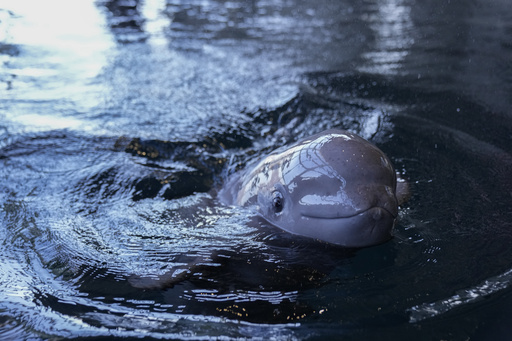
CHICAGO — At Chicago’s Shedd Aquarium, Charlie Jacobsma lightly tapped the surface of a pool enclosure, attentively watching for any activity in the water.
Soon enough, the head of a young beluga calf broke the surface, its mouth open in what appeared to be a joyful expression. Jacobsma’s face brightened as he interacted with the calf, cooing affectionately, reminiscent of a parent communicating with a small child.
This newest addition to the aquarium, a calf born to the 35-year-old beluga named Naya in July 2024, is already drawing attention for his playful demeanor.
Jacobsma, who oversees animal behavior and training at Shedd, likened the calf’s developmental phase to that of a child learning to speak. “He’s constantly making noises and growing,” he said, emphasizing the exciting nature of the calf’s journey.
As part of the calf’s early care, Jacobsma fed him several herrings, mentioning that he hasn’t developed his teeth yet. For the team at Shedd, each birth is a momentous occasion, and marking the first beluga born there in four years is particularly special. Since 1991, the aquarium has celebrated 15 such births.
The birth scenario that summer evening involved all staff members, as divers worked in the water to ensure everything went smoothly. Bella, another female beluga, aided the newborn by helping him to the surface before Naya took charge of the calf.
Now playfully called “Baby Boy Beluga,” the calf is gradually being acclimatized to the rest of Shedd’s group of eight whales. Members of the aquarium community are participating in a vote to help decide on an official name for the young whale.
In their natural habitat, belugas reside in isolated Arctic and sub-Arctic regions, making research difficult. Consequently, much of the available knowledge about belugas, especially in regards to their birthing process, has been cultivated in controlled environments like Shedd, according to Jacobsma.
The largest belugas at the aquarium can reach lengths of up to 14 feet (4.26 meters) and can weigh over 2,000 pounds (900 kilograms). These magnificent creatures typically thrive for several decades in aquariums, with some reaching their 30s, as noted by Shedd spokesperson Kayley Galassini. She also mentioned that some belugas born at the aquarium are relocated to other accredited institutions once they mature.
At Shedd, all animals are trained to voluntarily engage in their healthcare routines, allowing staff to monitor pregnancies through advanced techniques like ultrasounds.
When asked about what still fascinates him about the young beluga and the Shedd pod, Jacobsma pointed to their unique interactions—specifically, the sensation of tongue tickles.
“I really don’t know who figured it out first, but their mouths are incredibly sensitive, likely due to the kind of prey they consume from the ocean floor,” he remarked. “It’s quite akin to the experience of petting a dog or cat; they respond by wanting to engage with us and usually open their mouths wide to enjoy those tongue tickles.”

